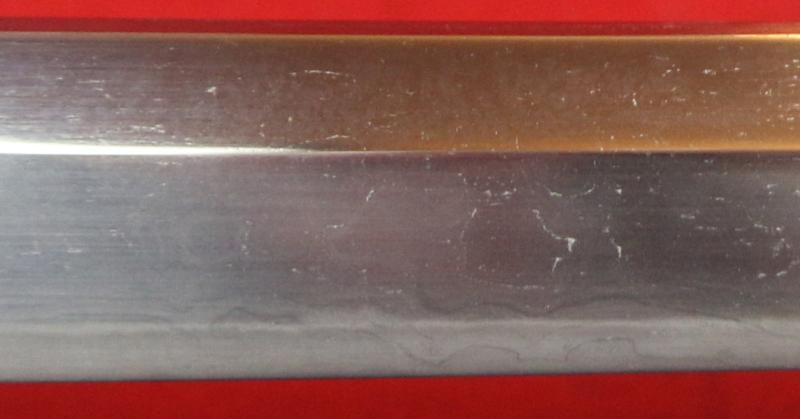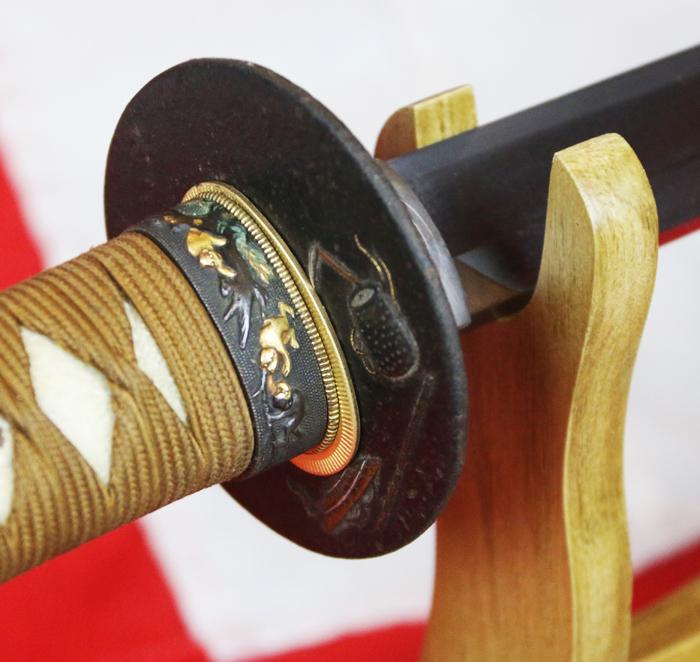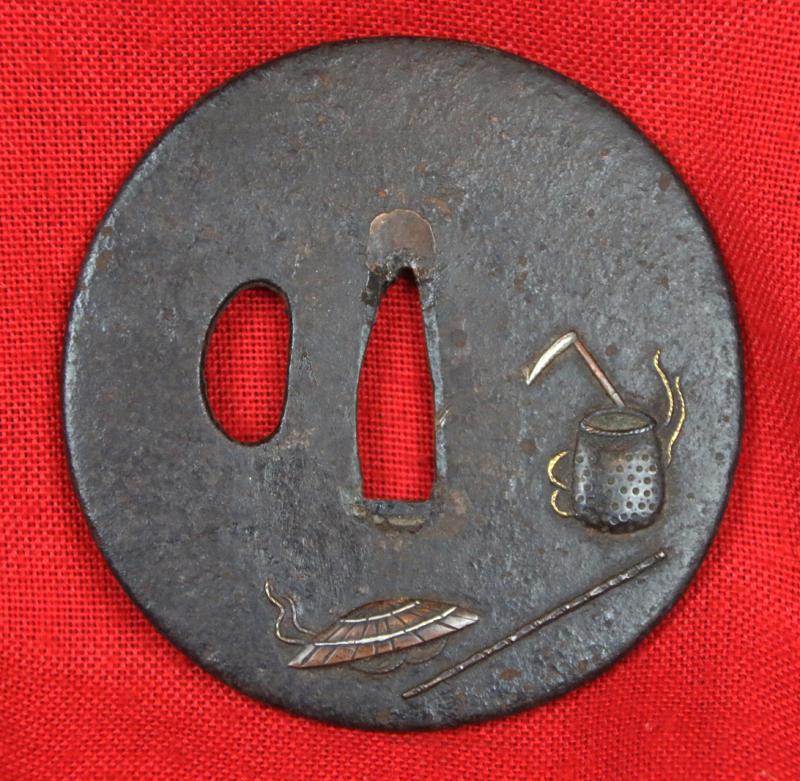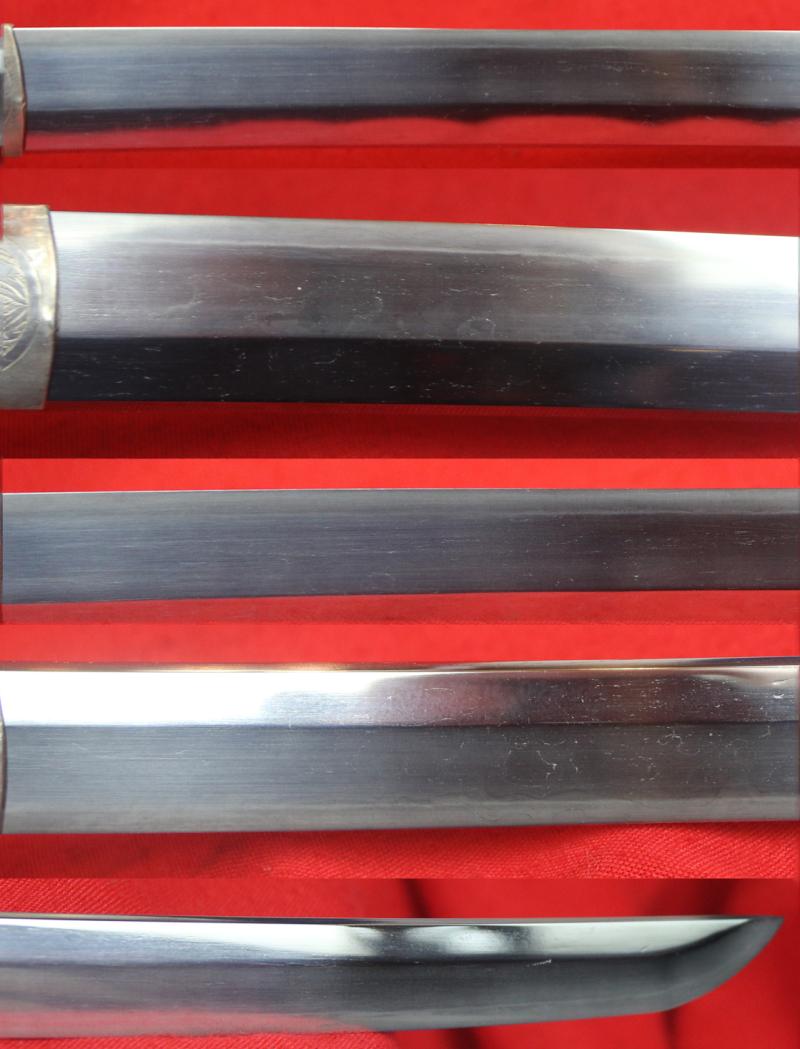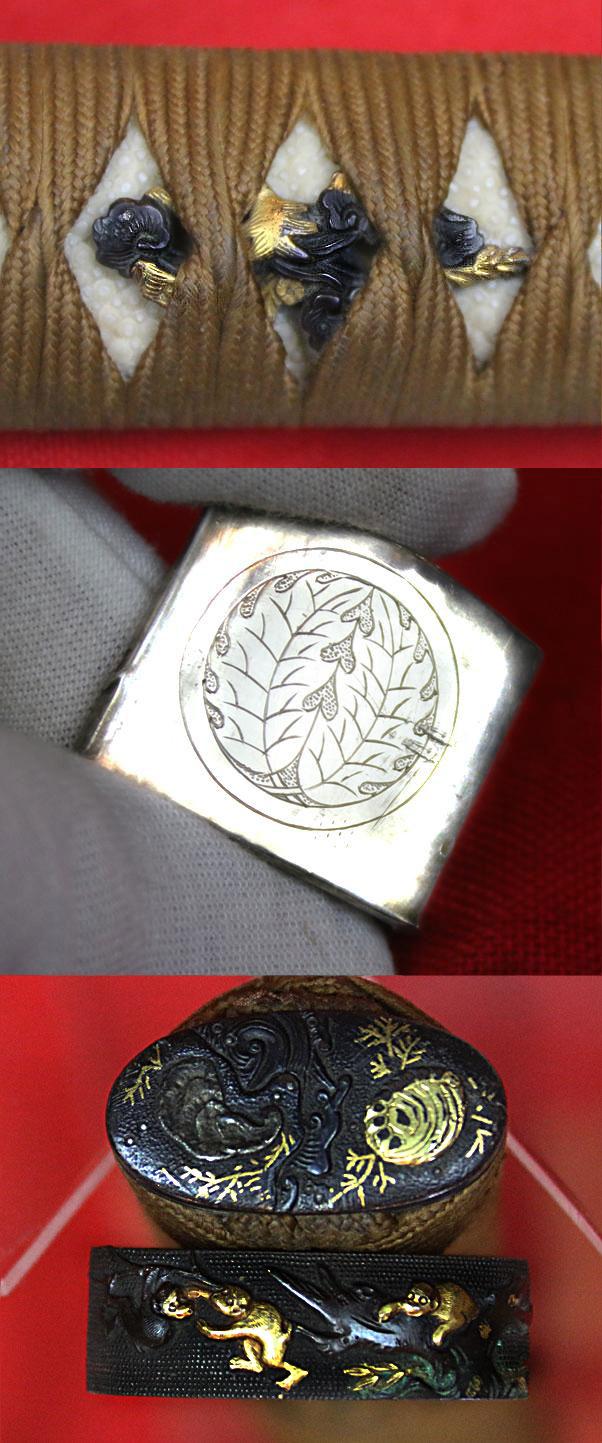A Superb 500 Year Old Koto Era Muramachi Period Katana With Clan Mon Of The Atagi Clan of Naval Samurai. Silver Habaki Engraved with the Atagi Crest Mon
Superb Koto blade in very fine polish showing stunning activity. When it first arrived the blade looked super but had a few very light old fingerprint stains, after two months away for conservation it now looks absolutely wonderful, likely just as it did when it left Japan after it was presented to an Englishman in the 1870’s. It has very fine quality Edo period shakudo and shibuishi mounts, including a fuchi decorated with takebori pure gold monkeys climbing a tree on a nanako ground.
Nanako Ji: "fish roe ground" A surface decoration produced by forming very small raised bosses by a sharply struck punch or burin called 'nanako tagane'. Shakudo is the metal most often used, but copper and gold are quite often employed. The harder metals, shibuichi, silver and iron are rarely decorated in this way. The size of the dots vary from 0.04" to 0.008" (25 to 125 and inch) and the regularity of the work is marvellous as the dots must be spaced entirely by touch. The dots are usually arranged in straight lines or in lines parallel to the edge of the piece being decorated, but sometimes in more elaborate patterns. Used on guards since the Momoyama period although the technique existed since much earlier periods. Usually done by specialist 'nanako-shi', but sometimes done by the maker of the guard himself.
A very similar example of a Fuchi with gold monkeys, possibly by the same Japanese craftsman, is in the Walters Art Museum in Baltimore USA.
The kashira is decorated with gold and silver sea shells and sea grasses, and the tsuba has a shakado basket, a jingasa helmet and the ninja angle bladed hand weapon with chain called a Kusarigama, and a ninja shikome-zue a hidden sword disguised as a walking stick. Very fine pure gold decorated shakudo menuki under the Edo silk binding, and the Edo saya has a fine ishime stone finish lacquer. Very good and well defined gunome based on suguha hamon.
Used by a high ranking samurai retainer of the samurai Governor of Settsu, Fuyuyasu, who in his turn served as a highest rank retainer of the Miyoshi clan and a samurai Captain of the Awaji Navy. He was the third son of Miyoshi Motonaga and adopted by the Atagi clan. The Atagi were related to the Miyoshi clan and served the Mioyshi clan. They commanded ships for the Miyoshi clan crewed by samurai. Fuyuyasu served as captain of the Awaji Navy in support of the Miyoshi governance, but was killed by his eldest brother, Miyoshi Nagayoshi. There are many views and uncertainties regarding the reasons for the incident.
Fuyuyasu’s father, Motonaga, reached a settlement with Hosokawa Harumoto, in 1531, only to be killed the following year by monks acting in concert with Harumoto’s rival, Hosokawa Takakuni. Harumoto served as a sengoku daimyō and kanrei, or deputy shōgun, to Ashikaga Yoshiharu. Harumoto was the final kanrei of the Muromachi period to exercise real authority.
The Atagi clan served as the navy for Awaji Province. His older brother, Nagayoshi, was driven out of the Kinai and went to the island province of Awaji. Nagayoshi arranged for Fuyuyasu to be adopted by Atagi Haruoki, lord of the Atagi clan, and to become his successor.
On behalf of the Miyoshi clan, Nagayoshi led soldiers on battles in Settsu, Kawachi, and Izumi provinces. Fuyuyasu’s next eldest brother, Miyoshi Jikkyū, operated in Awa Province. Fuyuyasu served in Awaji, and his younger brother, Sogō Kazumasa, in Sanuki Province. Fuyuyasu participated in suppression actions near Ōsaka Bay, the Battle of Kitashirakawa against Hosokawa Harumoto in 1558, and the Battle of Kumeda against Hatakeyama Takamasa in 1562, causing the loss of his brother, Jikkyū. Fuyuyasu retreated to Awa, and just months later, prevailed against Takamasa at the Battle of the Kōkyō Temple in the Takayasu District of Kawachi Province.
Thereafter, Kazumasa, Jikkyū, and Miyoshi Yoshioki (Nagayoshi’s eldest son and Fuyuyasu’s nephew), all died in succession. Fuyuyasu made great efforts supporting Nagayoshi in a bid for survival of the Miyoshi family. Nevertheless, in 1564, Fuyuyasu was summoned to Iimoriyama Castle and forced to kill himself at the age of thirty-eight. His son, Atagi Nobuyasu, became his successor. The naval history of Japan began with early interactions with states on the Asian continent in the 3rd century BCE during the Yayoi period. It reached a pre-modern peak of activity during the 16th century, a time of cultural exchange with European powers and extensive trade with the Asian continent.
The Sengoku period (15th–16th century)
Various daimyo clans undertook major naval building efforts in the 16th century, during the Sengoku period, when feudal rulers vying for supremacy built vast coastal navies of several hundred ships. The largest of these ships were called atakebune. Around that time, Japan seems to have developed one of the first ironclad warships in history, when Oda Nobunaga, a Japanese daimyo, had six iron-covered Ō-atakebune ("Great Atakebune") made in 1576 . These ships were called tekkosen (鉄甲船), literally "iron armoured ships", and were armed with multiple cannons and large calibre rifles to defeat the large, but all wooden, vessels of the enemy. With these ships, Nobunaga defeated the Mori clan navy at the mouth of the Kizu River, near Osaka in 1578, and began a successful naval blockade. The O-atakebune are regarded as floating fortresses rather than true warships, however, and were only used in coastal actions. After over two centuries of self-imposed seclusion under the Tokugawa shogunate, Japan's naval technologies became outdated compared to Western navies. The country was forced to abandon its maritime restrictions by American intervention with the Perry Expedition in 1854. As to be expected the blade has a few light fingerprint stains. overall in saya 37.25 inches, blade tsuba to tip 26.3 inches long It is important to bear in mind, that due to the revered status that Japanese swords achieve for most of their working lives in Japan, that the condition they survive in can be simply remarkable. One can see just how remarkable it can be, by comparing the condition of this fine sword that was made around the same time as the early Tudor period of King Henry the VIIIth to any equivalent aged, surviving, early Tudor period sword, from any country outside of Japan, and that comparison will show just how fine any Japanese sword’s state of preservation, from the same era, truly can be.
Code: 23644
7450.00 GBP



